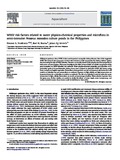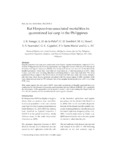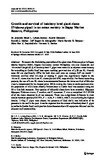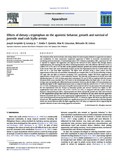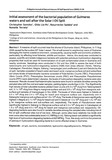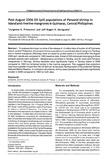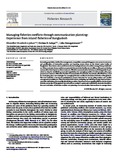Journal Articles: Recent submissions
341-360 / 1234
-
Influence of salinity on survival and molting in early stages of three species of Scylla crabs
(Society of Israeli Aquaculture and Marine Biotechnology (SIAMB), 2011)Early instars of three mud crab Scylla species were reared in different salinities and survival and growth were compared. Scylla olivacea were reared in salinities of 12, 16, 20, 24, and 32 g/l (control). Scylla serrata ... -
Prevalence of viral nervous necrosis (VNN) virus in wild-caught and trash fish in the Philippines
(European Association of Fish Pathologists, 2011)Viral nervous necrosis (VNN) caused by piscine nodavirus is a devastating disease affecting mainly marine finfish. In the Philippines, VNN was first reported in hatchery-reared grouper (Epinephelus coioides) broodstock in ... -
Growth and feed efficiency in mangrove red snapper, (Lutjanus argentimaculatus Forsskal 1775) fed practical diets supplemented with L-ascorbyl-2-monophosphate-Mg
(Society of Israeli Aquaculture and Marine Biotechnology (SIAMB), 2011)Growth and feed efficiency were determined in red snapper, Lutjanus argentimaculatus (Forsskal 1775), fed diets containing L-ascorbyl-2-monophosphate-Mg (AMP). Fish (13.39±0.08 g) were fed a practical diet without vitamin ... -
Effects of UV-treated sea water, chlorinated sea water, and formalin-treated copepods on survival and growth of newborn seahorses, Hippocampus comes
(Society of Israeli Aquaculture and Marine Biotechnology (SIAMB), 2011)Seed production of the seahorse Hippocampus comes was examined using different types of sea water (UV-treated, chlorinated, sand-filtered), and formalin-treated copepod Pseudodiaptomous sp. as a food organism. Growth and ... -
Potentials of Kappaphycus striatum (Schnitz) and Gracilaria heteroclada Zhang (Ad Xia) to control the growth of luminous bacteria Vibrio harveyi
(University of the Philippines Los Baños, 2010)Different aquaculture species such as finfishes and bivalves have been reported to control the luminous bacterial disease of shrimp, usually caused by Vibrio harveyi. The use of seaweeds in shrimp culture system has ... -
WSSV risk factors related to water physico-chemical properties and microflora in semi-intensive Penaeus monodon culture ponds in the Philippines
(Elsevier, 2010)Whitespot syndrome virus, WSSV, is the most important among the shrimp diseases. One of the suggested WSSV risk factors is the occurrence of stress since stressors could compromise the shrimp defence system thus increasing ... -
Effect of different sizes of saline red tilapia hybrid Oreochromis niloticus Linnaeus x O. mossambicus Peters on the growth of luminous bacteria Vibrio harveyi
(College of Agriculture, University of the Philippines Los Baños, 2010)Luminous bacterial disease caused by Vibrio harveyi has devasted the shrimp industry. The use of different strains of tilapia and other fish species polycultured with shrimp cultured at a salinity of 24 ppt to control ... -
Koi herpesvirus-associated mortalities in quarantined koi carp in the Philippines
(European Association of Fish Pathologists, 2010)Illegally imported koi carp were confiscated at the Ninoy Aquino International Airport (NAIA), Manila, Philippines by the Fisheries Quarantine and Inspection Service Officers of the Bureau of Fisheries and Aquatic Resources ... -
Growth comparison of Asian Nile and red tilapia strains in controlled and uncontrolled farm conditions
(European Aquaculture Society, 2010)Growth of several genetically improved Nile tilapia (GIFT or Genetically Improved Farmed Tilapia, FaST or Freshwater Aquaculture Center Selected Tilapia, SEAFDEC-selected) and domesticated red tilapia (BFS or Binangonan ... -
Protective immunity against viral nervous necrosis (VNN) in brown-marbled grouper (Epinephelus fuscogutattus) following vaccination with inactivated betanodavirus
(Academic Press, 2010)Viral nervous necrosis (VNN) caused by betanodaviruses has been recently implicated in serious mortalities of groupers in the grow-out culture system. A safe and effective vaccine against this disease is urgently needed. ... -
Growing the reproductive cells (carpospores) of the seaweed, Kappaphycus striatum, in the laboratory until outplanting in the field and maturation to tetrasporophyte
(Springer Verlag, 2010)Carposporophytes of the seaweed, Kappaphycus striatum, from the wild were made to shed spores in the laboratory and grown in multi-step culture method until they reached maturity. For each succeeding transfer onto increasingly ... -
Growth and survival of hatchery-bred giant clams (Tridacna gigas) in an ocean nursery in Sagay Marine Reserve, Philippines
(European Aquaculture Society, 2010)To restore the diminishing population of the giant clam Tridacna gigas in Sagay Marine Reserve (SMR), Negros Occidental, central Philippines, two size classes [8- and 10-cm shell length (SL)] of hatchery-bred T. gigas were ... -
Effects of dietary l-tryptophan on the agonistic behavior, growth and survival of juvenile mud crab Scylla serrata
(Elsevier, 2010)The reduction of the survival of mud crab during culture has been largely attributed to aggressive encounters and cannibalism. In some crustaceans, suppressed aggression is linked to increased concentration of circulating ... -
Cloning of IGF-I, IGF-II and IGF-IR cDNAs in mullet (Mugil cephalus) and grouper (Epinephelus coioides): Molecular markers for egg quality in marine fish
(Knowledgia Scientific, 2010)The putative cDNA sequence of insulin like growth factor (IGF)-I, IGF-II and IGF-IR (receptor) was determined from the tissues of mullet, Mugil cephalus and grouper Epinephelus coioides. The deduced partial coding sequences ... -
Settlement, growth and survival of donkey's ear abalone Haliotis asinina (Linne) in response to diatom diets and attachment substrate
(Science and Technology Information Institute, 2010)The effect of feeding four diatom diets (Amphora sp., Navicula ramosissima, Amphora sp. + N. ramosissima, and mixed diatoms) and two attachment substrates (PP+CCA: polyvinyl plates with crustose coralline algae; PP-CCA: ... -
Initial assessment of the bacterial population of Guimaras waters and soil after the Solar I oil spill
(University of the Philippines Visayas, 2009)A massive oil spill occurred near the shores of Guimaras Island, Philippines in 11 Aug 2006 caused by the Sunken MT Solar I vessel. The oil spill spread to neighboring towns of Guimaras damaging the marine coastal environment, ... -
Post-August 2006 oil spill populations of Penaeid shrimp in island and riverine mangroves in Guimaras, central Philippines
(University of the Philippines Visayas, 2009)To evaluate the impact on biota of the release of arrow up million liters of bunker oil off Guimaras Island, Central Philippines, the penaeid shrimp populations in a protected island mangrove (Tandog) and a riverine mangrove ... -
Immune responses of Asian sea bass, Lates calcarifer Bloch, against an inactivated betanodavirus vaccine
(Blackwell Publishing, 2009)Asian sea bass, Lates calcarifer (Bloch), exhibited strong immune responses against a single injection of the formalin-inactivated red-spotted grouper nervous necrosis virus (RGNNV), a betanodavirus originally isolated in ... -
Managing fisheries conflicts through communication planning: Experience from inland fisheries of Bangladesh
(Elsevier, 2009)Increasing population, ineffective management, competition among fishing gears over access to resources and proliferation of destructive practices are imposing severe stress on the inland water bodies of Bangladesh. These ... -
Surveillance of emerging fish viral pathogens in some Southeast Asian countries
(Society of Israeli Aquaculture and Marine Biotechnology, 2009)Preventing the transboundary movement of fish viral pathogens in a global environment requires active surveillance. This study examined the presence of three emerging viral pathogens among koi, common, grass, and silver ...






